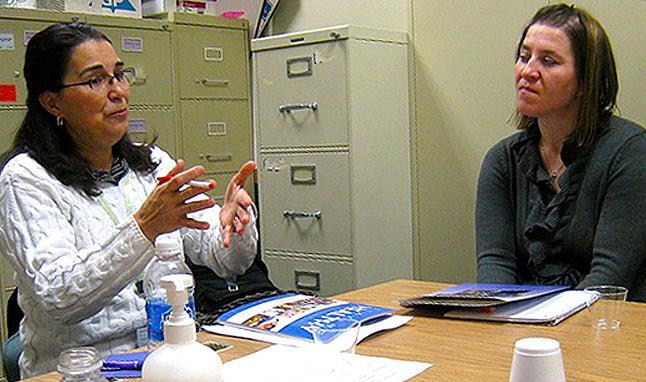Mayo, Minn. communities targeting immigrant health
The Rochester Healthy Community Partnership recently received a five-year, $1.7 million grant from the National Institutes of Health to look for ways to improve the health of the region's growing minority communities.
This is part of a 3-part fellowship:
Part 1: For Latino immigrants, good health hard to maintain
Part 2: Mayo, Minn. communities targeting immigrant health

Rochester, Minn. — In a first-of-its-kind collaboration, researchers at the Mayo Clinic are working with more than a dozen community organizations to keep immigrants and refugees from developing common diseases like diabetes, high blood pressure and obesity.
The project, which includes nursing students at Winona State University in Rochester, focuses on southeast Minnesota, an area of the state that has seen some of the largest demographic shifts in the last decade.
"This is a community dedicated to health and we have a lot of people who aren't healthy living here," said Julie Nigon, program manager at the Hawthorne School, a community and adult education center in Rochester.
The Hawthorne School is often the first stop for immigrants and refugees new to the city. They learn to speak English, take civics classes and meet other immigrants.
The school is a crucial part of a project launched late last year with Mayo researchers and other community groups to develop Healthy Immigrant Families: Working Together to Move More and to Eat Well. The effort aims to create physical activity and nutrition programs with and for immigrant and refugee families.
The Rochester Healthy Community Partnership recently received a five-year, $1.7 million grant from the National Institutes of Health to look for ways to improve the health of the region's growing minority communities.
Nigon said the project will focus on finding ways to connect resources already available in the community with the people who need them.
"We have many athletic facilities: we have the athletic club, we have the Y, we have golf courses, and tennis courses, walking trails, bike trails," she said. "But are people accessing them, especially in the target population we're working with?"
Nobody knows exactly what it will take to get people to move more and eat well.
But barriers to physical activity and nutrition are especially acute among immigrant women, said Miriam Goodman a member of Rochester's Alliance of Chicanos, Hispanics and Latin Americans.
"If I target the moms, mom will make the effort to exercise," Goodman said.
Last fall, Goodman coordinated a six-week fitness program for 45 immigrant and refugee women in Rochester. She said it was the first exercise class for many of them in a group environment.
"I believe moms having fun will pass it on to their own girls," she said. "They will be targeting that kind of intervention for their own children to feel better, to walk together, to exercise, not to eat that much when [they] already know how much it takes to burn calories in one hour of zumba."
Health care providers say addressing the health needs of refugees and immigrants is increasingly important, as a growing number call rural Minnesota home.
From 2000 to 2010, Rochester's population grew by 21 percent to 103,000 residents. About 10.4 percent of Olmsted County residents do not speak English as their primary language at home. That's up 6 percent since 2000, according to the U.S. Census bureau.
Much of this growth comes from immigrants and refugees, who are generally healthier when they arrive in the United States than non-Latino whites. But within a generation, they become almost twice as likely as whites to develop diabetes and other chronic diseases.
In part, the problem stems from low levels of family income and education.
Latino adults are up to five times more likely to be uninsured than whites, according to the Minnesota Department of Health.
Also, poor families tend to stretch their budgets by buying fewer fresh fruits and vegetables and more high-calorie, low-cost convenience food, according to National Council of La Raza researchers.
Nursing students at Winona State University in Rochester are now part of the project to encourage healthy immigrant families. Graduate nursing students will work with community liaisons to serve as healthcare mentors.
Nursing Professor Carole Jenson tells students this part of their nursing training will emphasize cultural understanding. With the help of community liaisons who speak patients' native languages, students will conduct home visits, go to churches and supermarkets, and build relationships with immigrant patients outside of the hospital and classroom walls.
"If nothing else this semester, build trust," Jenson advises.
Graduate nursing student Sara Berding has worked as a nurse for 10 years in Mason City, Iowa. She said gaining the trust of her patients is a daily challenge, especially when language is a barrier.
"We're relying on pictures and gestures and we know just a few words," Berding said. "When there's no interpreter, it's so frustrating for the parents. We just always worry when we send them home, what are we sending them home with? Do they know what their child had? Do they understand? It's just so frustrating."
While some community groups search for ways to explain more about cultural nuances, others are focused on how to monitor the health progress of patients in the project.
Mayo Clinic Dr. Mark Wieland said he's trying to figure out what programs works best for each community. He'll monitor the progress of 40 patients, who will participate in a second round of physical fitness and nutrition classes starting in February.
"The measures that we're taking and the primary outcomes are literally physical activity as measured by accelerometers that people wear," he said. "They measure how much movement they have... and likewise, secondary measures are things you might expect, blood pressure, height, weight, and body fat."
Wieland said there's no single reason why immigrants and refugees are at a greater risk for developing chronic diseases. But he said providing interpreters and training health care workers to understand their culture is one way to try to keep them healthy.

